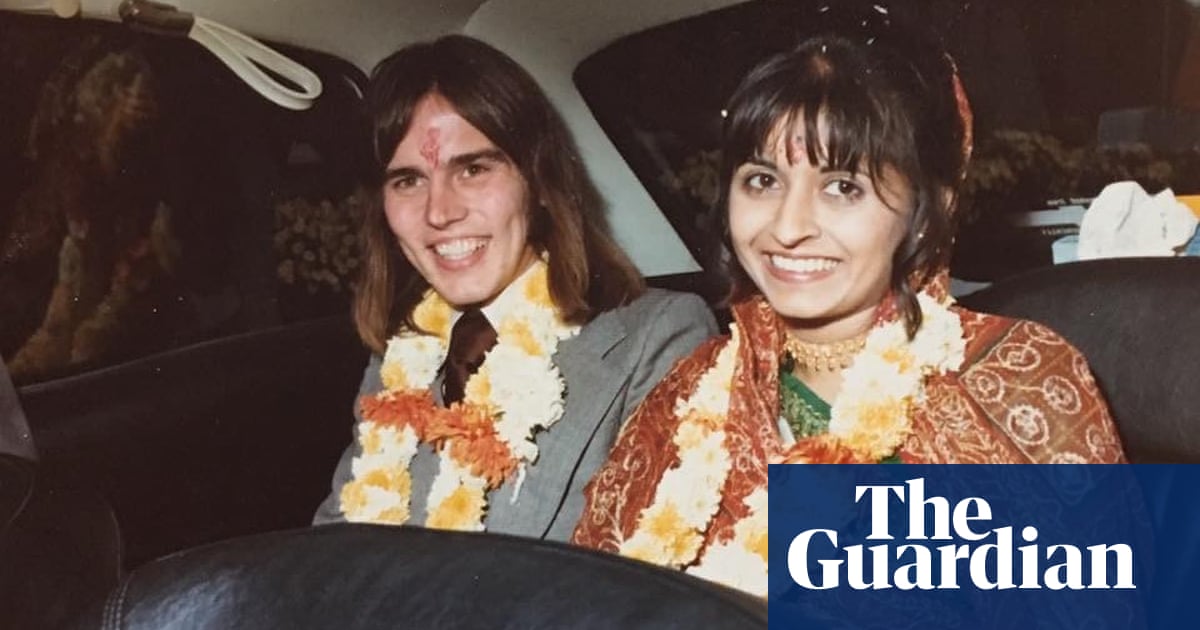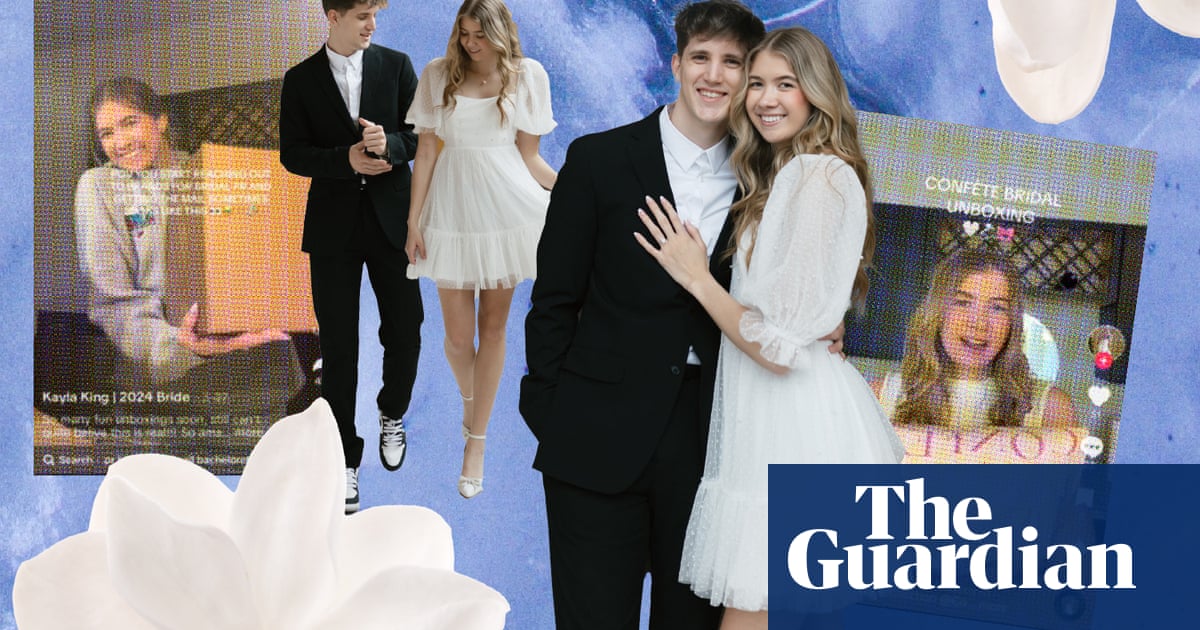
icture this: the very first celebratory night out you will have when the vaccine sets us free. Maybe you’re in a fancy restaurant, maybe your local pub. Cosy around a friend’s kitchen table, or on a packed dancefloor. What are you wearing? Are you desperate to wriggle back into a party dress and brave your highest heels? Or have sweatpants spoilt you for anything that doesn’t have an elasticated waistband and a fleece lining?
For a year, most of us have had the same hobbies (Netflix and going to the park) and as a result have worn pretty much the same thing (loungewear and puffer jackets). But post-vaccine, we are set to split into two style tribes. For every 21st-century swell desperate to re-enact the roaring 20s, there is someone who has found solace in the soft textures of lockdown. Culture responds to trauma in a kaleidoscope of ways. After all, in the first half of the decade that followed the first world war and the Spanish flu pandemic, F Scott Fitzgerald wrote The Great Gatsby, while TS Eliot wrote The Waste Land.
One dark, wet, locked-down weekend in January, I sent emails and WhatsApp messages around the fashion industry, posing the question: what will you wear once the vaccine sets us free? Responses came thick and fast from devotees of dressing up, many of whom, it was clear, were already planning outfits. “When I think about life post-pandemic, all I can think about is endless parties,” Alexa Chung said. She will be in “eye-wateringly short bodycon dresses – I may need matching knickers – and high heels”. (For the record: I am putting good money on a post-pandemic craze for miniskirts.) Victoria Beckham predicted “a roaring-20s-style return to indulgence, in a great dress or a tuxedo, with a heel”. Laura Bailey, contributing editor at Vogue, told me how she recently found herself scrolling for clothes online “when I should be working or home schooling. Almost as if imagining a certain look or mood could edge the idea of freedom and reunion closer.” (In her virtual basket: a white, stretch-lace Stella McCartney dress and a pair of Chanel boots.) “I’ll be wearing full Met Gala looks to the pub the instant I’m allowed out,” said Lauren Grant, designer of made-in-London haute-shirting brand S.A.R.K. The cofounders of fashion communications agency Aisle 8, Virginia Norris and Lauren Stevenson, are dream-planning outfits for tequila nights at a rooftop bar near their east London office. Norris will be in gold, snakeskin print Gianvito Rossi platform sandals; Stevenson in a bandage dress. “I have a gut feeling my Hervé Léger collection will be back with a vengeance soon,” she said. It sounded like a prayer for deliverance.
But this is only half the story. It is thanks to a voracious new appetite for loungewear that the fashion industry has its head above water at all, at this point. Tracksuits, leggings, pyjamas and casual wear have gone from strength to strength. “In the past year I have made a conscious effort to buy quality loungewear rather than sit around in an old T-shirt. It helped to elevate what has been a disastrous and mind-numbing experience,” says author and presenter Candice Braithwaite, who invested in Sleeper house dresses and cosy pieces from Kim Kardashian’s Skims range.
Most brands have looked at their most recent sales figures and are backing casual clothes as their most reliable bet through the remainder of 2021. The first catwalk shows of this year featured long johns at Prada, hoodies at Etro, and pyjama sets at Fendi. Boden’s customer will be dressing down her usual floral shirt-dress this summer by adding trainers and a baseball cap, predicts in-house stylist Sarah Corbett-Winder. (If offices open, she hopes to tempt her with “a great cuffed jogger that is smart enough for work”.) Andy Potter, who works at Marks & Spencer HQ as head of campaigns, events and brands, sees himself wanting “one outfit that enables me to stylishly but seamlessly move through my day: working or relaxing at home, walking in the park, or lunch down the pub. But if it’s not comfortable, I’m not interested.”
Lockdown’s loungewear uniform didn’t happen overnight. “At first, I was wearing proper shoes and ironed clothes. As if everything was just normal, and it would all be over any minute, and I could walk out the door and jump into a taxi,” recalls Osman Ahmed, fashion features editor of i-D magazine, about last March. Eventually he succumbed to the lure of (cashmere) tracksuit bottoms, which he has worn ever since. For much of 2020 it seemed that everyone – including the editor of US Vogue and the chancellor of the exchequer – was in sweatpants. Hattie Brett, editor of Grazia, invested in a Ven Store cashmere tracksuit. “It opened my eyes to loungewear as a category, something I’d never bought into before.” (On New Year’s Eve, however, having put on a dress and lipstick for “the inevitable Zoom quiz”, she was disappointed to find that most of her friends were still in their hoodies.)
Covid-19 accelerated a casualisation of our wardrobes that was already in train. Long before the pandemic hit, heels were on their way down and casual wear on its way up. In 2019, sales of high heels fell by 12%, while those of athleisure clothing rose by 9%. The pandemic turbocharged this. Like many people who work from home at a laptop on a non-ergonomic chair, I have gravitated toward clothes that ease physical discomfort. I have a new wardrobe category I think of as my “smart leggings” – a concept I would previously have considered an oxymoron. M&S report record sales of all-day athleisure, with a £19.50 sweatshirt in grey marl embroidered with the word “happy” a January bestseller. “Yoga” is among its most-searched terms for online shoppers. “I think we have fundamentally changed the way we dress,” says Jill Stanton, M&S’s director of womenswear, beauty and kidswear. “Working patterns have probably changed for ever, and accessible, less formal work clothes will be key.”
Meanwhile, the rise of walking – as exercise, in order to avoid the risks of public transport, to meet a friend for a chat, or just as something to do – has prompted hikes in sales of outdoorwear from flat boots to puffer jackets. Indoors, dress historian Amber Butchart has spent most of lockdown in “leggings or thick woolly tights, coupled with sweater dresses or sweatshirt dresses”, but when her local vintage shops were open she stocked up on “Nordic knits and 1990s ski salopettes” for walks or bike rides.
The cultural aftershocks of the pandemic will change how we shop and how much we buy, as well as what we wear. A shift in values, as well as lifestyle, is already having an impact. “I want to have changed,” Vogue’s Bailey says. “I want to have absorbed the heartache, to have gathered strength and flexibility. I don’t want to pretend nothing has happened. The rhythm of my days has changed profoundly. I want to dress up and celebrate – but I also want to consume more consciously.”
Broadcaster Miquita Oliver, whose pre-pandemic shopping habits involved “a lot of charity shops, but also a lot of Zara”, has met the challenge of finding new on-screen outfits while shops are closed by “going through my wardrobe and realising I had so many things I’d never really styled”. Recently, while appearing on Steph’s Packed Lunch, she wore a longline blazer picked up for £5 from London’s Ridley Road market, which she turned into a dress by adding buttons. “I hope by wearing charity shop clothes on Channel 4 every week, I can show that they aren’t the lesser option,” she says. “I don’t think I’ll go back to consuming high street fashion in the way I did.”
Lockdown refocused our attention on what we each have at home, in fashion as in other aspects of life. “I’ve been doing a Dry Shopping January and it’s great. I’m ‘shopping’ in my wardrobe every day,” Boden’s Corbett-Winder says. Eshita Kabra-Davies, founder of peer-to-peer rental platform By Rotation, has realised that “I have so many beautiful pieces I’m still in love with, I really don’t need anything new. That revelation brought me back to basics.” During lockdown, her platform’s “rotators” have been active, renting “designer pyjamas, and dresses for birthdays”. With household incomes under pressure, and the lockdown-accelerated shift to conscious consumption, Kabra-Davies believes that post-vaccine parties will “add a tailwind to our concept of extending your wardrobe to a like-minded community”.
But what can we learn from fashion history? The idea that we are poised for a rerun of the roaring 20s is an appealing one right now – a silk dress, a spin in an open-top car, a gilt-rimmed saucer of champagne – but the impact of the pandemic is unlikely to be so simple. Fashion processes shock and upheaval in the strangest of ways. In Paris, in the last decade of the 18th century, a fashionable finishing touch to the punk-socialite fashion of the Incroyables was a slim red satin choker at the throat, to reference the slicing of the guillotine. “We emerge from a pandemic having faced this terrible reminder that being part of a society involves taking risks,” says Claire Wilcox, senior curator of fashion at the V&A museum in London. The exuberant flapper-dress aesthetic “expresses a kind of bravado in the face of death”, while the dandyesque menswear of the interwar years “was in some ways an outpouring of emotional trauma after the appalling loss of young men in the first world war,” Wilcox notes. The brittle glamour of the golden age spoke of an urgent, almost fatalistic insistence on taking pleasure in the moment.
The truth of post-vaccine fashion will likely lie somewhere between the two extremes of hotpants versus hibernation. Beckham emails from Miami to say she is looking forward to wearing the vintage denims she has lived in for months with heels rather than trainers. Stevenson agrees with me that “smart leggings” will be coming with us out of lockdown, but not sweatpants. Grant’s subversive S.A.R.K silk shirts, with feature buttons made from ring-pulls or bi-colour pill capsules, have been a Zoom hit – “They show up beautifully on camera as the light catches the silk, so we’ve had a few customers buying shirts they’d seen on someone else in a Zoom meeting” – but she can’t wait to complete the look with proper trousers. The opposite of a tracksuit, Ahmed points out, is “not ballgowns or sharp suiting, but outfits. Clothes that you have had fun putting together.”
This is not just about what we want to wear post-vaccine. It’s about the lives we want to live. “The other day I picked up my favourite Manolos and actually blew the dust off them,” Braithwaite says. “I’ve been working really hard with my personal trainer so that once Covid-19 is in the rear-view mirror, I can give them the Tina Turner legs they deserve.” David Gant, Weekend’s own All Ages icon, spent lockdown teaming his signature black polo neck with sweatpants, but intends to swap those for a kilt, complete with kilt hose and flashes, “to wine and dine at the Savoy Grill, or the Ritz”. And this appetite for life and adventure isn’t just about climbing on to bar stools. “More than anything, I want to climb a mountain and swim in the ocean,” says Bailey, who yearns for freckles, a tan and salty mermaid plaits. “Oh, I am just dying to have somewhere to dress up for,” Ahmed says. “I cannot wait to be standing in front of my wardrobe, pondering what belt goes with what shoes, while friends are looking at their watches somewhere, wondering where on earth I am.”
My lockdown look
David Gant, model and All Ages regular
My lockdown outfit has been sweatpants, trainers, my usual black polo neck jumper and a hand-knitted pullover. Wearing casual clothes in lockdown has been so comfortable that I will keep wearing them, both indoors and out. In fact, partnering them with more formalwear is fun. But I do look forward to dressing up again, to the excitement of it all. I want to wear one of my kilts; I have a Black Isle tartan and one in my mother’s tartan, the Modern Ferguson. And I’ll wear a black polo neck, Cos jacket, kilt hose and flashes, and I will wine and dine at the Savoy Grill or the Ritz. Whatever you wear, wear it with style!
Candice Braithwaite, presenter and author of I Am Not Your Baby Mother
The way I dress now is much less constructed and less constrictive than it used to be. Prior to Covid-19 I went out a lot, and I was constantly in a high glittery heel and a dress that I needed shapewear under or to shave my legs for. Over the past year I have started to see and understand that I was dressing with being on show in mind. After a year looking at my wardrobe, I can see that sometimes I purchased an item because it was trendy or looked great on someone else. Now I consciously dress for me – and I really hope that’s something I can carry with me once freedom comes back. I am so excited to have somewhere to dress up for. I can’t wait to rub shoulders with strangers again and not be frightened. Dressing up is the foreplay to all that. But this time I won’t be wearing a tight dress. I want to be able to go out and enjoy a four-course meal.
Eshita Kabra-Davies, founder of fashion loaning website By Rotation
I was confused about my style while I was making the switch from investment banker to fashion tech founder. One day I’d wear a bright maxi dress for an event; another day a monochrome suit for a headshot photo. Over lockdown, I spent time considering my existing wardrobe and what truly made me feel like my personality was reflected in my fashion choices. I have so many beautiful pieces I’m still in love with, I really don’t need anything new. That revelation brought me back to basics, to high-waisted trousers, plain T-shirts, smart blouses and jumpers, tailored dresses and court heels. As soon as a hint of normality returns, I expect many people will take pride in dressing up again. We have read about “revenge buying” in China [post-lockdown splurges], and I believe there is pent-up demand for enjoying life to the fullest and going all out when dressing for social occasions.
Osman Ahmed, fashion writer
Last year I invested in a pair of cashmere tracksuit bottoms, which I’ve been wearing with a rotation of cashmere sweaters. That’s it: that’s what I’ve worn for what feels like the last 10,000 years. I will happily be putting those track pants to one side, maybe reserving them for Sunday evenings. But I think, much like politics and culture, our wardrobes have become incredibly divided. Some designers are adamant about maintaining dress codes and appearances; others are enjoying the newfound ease. There are people proclaiming that they will never wear heels again, and others (like me) counting down the days until I can slip on a pair of zebra, calf-hair Harris Reed x Roker seven-inch platform boots.
Amber Butchart, fashion historian
Like many people, my lockdown style has become more casual. A lot of jersey. What even are high heels any more? But some of my style was already set for lockdown life – loungewear glamour is something I’ve long had an interest in. Think Gloria Swanson in Sunset Boulevard. I’m a big fan of turbans – ideal for hiding lockdown hair – and over summer I wore a lot of 60s short sheath dresses (no waistband!) and towelling beach jackets. But I am looking forward to wearing nice shoes again! And more jewellery, which has fallen by the wayside this past year.
• Comments on this piece are premoderated to ensure the discussion remains on the topics raised by the article. Please be aware that there may be a short delay in comments appearing on the site.












